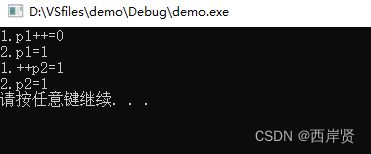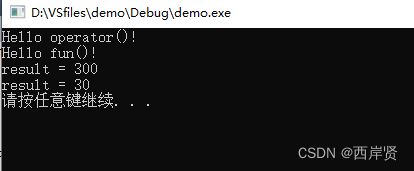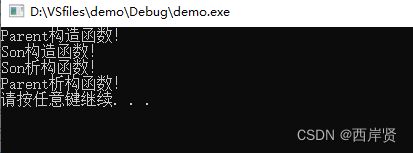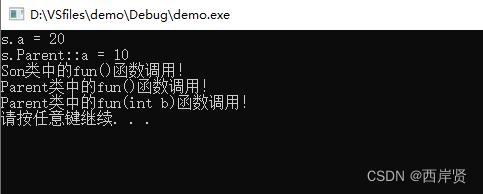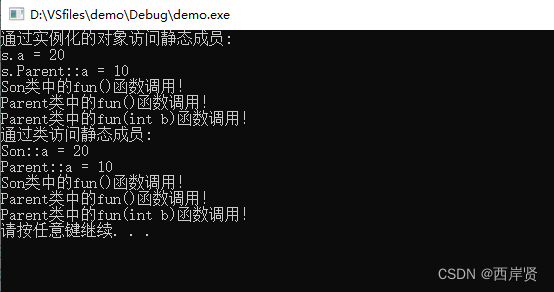从0到1入门C++编程——05 类和对象之运算符重载、继承
文章目录
- 运算符重载
-
- 1.加号运算符重载
- 2.左移运算符重载
- 3.递增运算符重载
- 4.赋值运算符重载
- 5.关系运算符重载
- 6.函数调用运算符重载
- 继承
-
- 1.继承的基本语法及继承方式
- 2.继承中的对象模型
- 3.继承中构造函数和析构函数的顺序
- 4.继承中同名成员的处理方式
- 5.继承中同名静态成员处理方式
- 6.继承多个父类
- 7.菱形继承
运算符重载
运算符重载是对已有的运算符重新进行定义,赋予其另一种功能,以适应不同的数据类型。
1.加号运算符重载
加减乘除运算符的重载是一样的,只需要将operator后面的符号换成相应的运算符即可,下面以加号运算符的重载为例。
成员函数重载+运算符。
#include 全局函数重载+运算符。
#include 2.左移运算符重载
重载左移运算符配合友元可以实现自定义数据类型的输出。
左移运算符重载不能在成员函数中实现,因为涉及到传参,cout应在类前面。
转到cout的定义处,其是一个ostream类型的变量。
__PURE_APPDOMAIN_GLOBAL extern istream cin, *_Ptr_cin;
__PURE_APPDOMAIN_GLOBAL extern ostream cout, *_Ptr_cout;
左移运算符重载的代码如下。
#include 3.递增运算符重载
前置递增运算返回引用,后置递增运算返回值。
递增运算符重载的代码如下。
#include 4.赋值运算符重载
赋值运算符重载是为了实现涉及堆区内存的拷贝,要以深拷贝的形式实现,浅拷贝的方式在析构函数执行时会发生错误。
赋值运算符重载的代码如下。
#include 5.关系运算符重载
重载两个关系运算符,可以让两个自定义类型的对象进行对比。
关系运算符重载的代码如下。
#include 6.函数调用运算符重载
函数调用运算符是 () ,由于重载后使用的方式像函数调用,因此称为仿函数,仿函数没有固定写法,非常灵活。
函数调用运算符重载的代码如下。
#include 继承
1.继承的基本语法及继承方式
继承是面向对象的三大特性之一。
类与类之间存在特殊的关系,比如下面的类中,下级的成员除了拥有上一级的共性外,还有自己的特性。
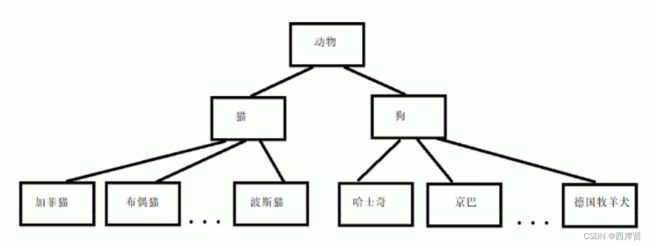
这个时候可以使用继承,减少重复的代码,这也是通过继承带来的好处。
继承的语法:class 子类名 :继承方式(public等) 父类名
继承方式包括公共继承(public) 、保护继承(protected) 和私有继承(private) 。
父类也称基类,子类也称派生类。
派生类中的成员包含两部分,一部分是从基类继承过来的,一类是自己增加的成员,从基类继承过来的表现为共性,子类中新增的成员体现了其个性。
通过公共继承(public) 方式,成员属性或方法在父类中是什么样的访问方式,在子类中还是怎样的访问方式;通过保护继承(protected) 方式,成员属性或方法在父类中是公共或保护访问方式的,在子类中以保护方式访问;通过私有继承(private)方式,成员属性或方法在父类中是公共或保护访问方式的,在子类中以私有方式访问;父类中私有的成员属性或方法在子类中不能被访问。保护权限下的成员属性或方法在子类内可以访问,子类外不可以访问。

如果再对子类做继承,同样要看继承方式,子类中私有的属性或方法经继承后全都访问不了。
值得一提的是,父类中的私有成员只是被隐藏了,但是仍然会继承下去。
网页中一般都是这样设计的,有公共的头部和底部信息,点开不同的链接之后,这些公有的信息没有变化,但是却有自己独有的部分,这就用到了继承。
如果不使用继承,对上面提到的网页例子以普通的方式来实现,代码如下所示。
#include 可以看到,不同的类中用到了许多重复的代码,如果采用继承的方式,优化后的代码如下。
#include 上面的两个代码运行结果是一样的,如下图所示,但是通过继承方式写出来的代码减少了很多的重复,这种重复在多继承的情况的尤为明显。
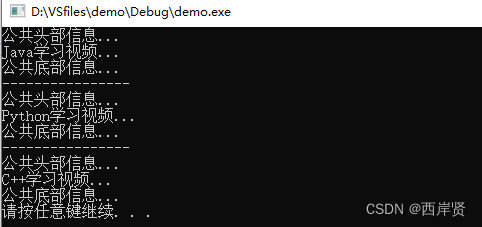
2.继承中的对象模型
父类中所有的非静态成员属性都会被子类继承下去,父类中的私有成员属性被编译器隐藏了,但是仍然会被继承。
下面代码很好的说明了父类中的哪些属性被子类继承了。
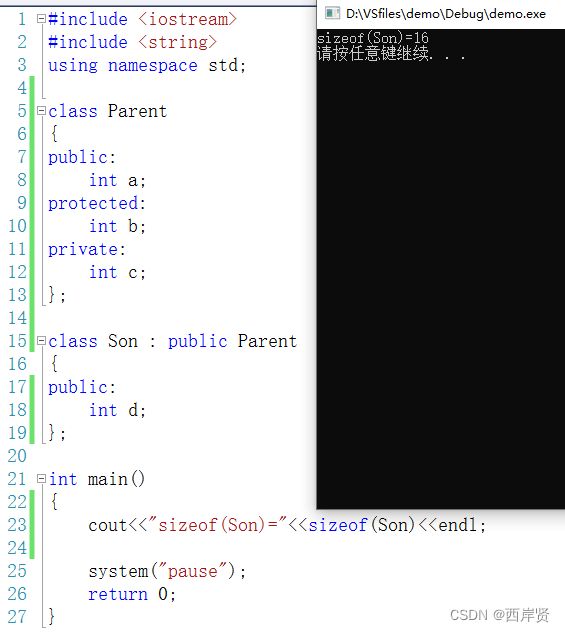
3.继承中构造函数和析构函数的顺序
先执行父类的构造函数,再执行子类的构造函数;析构函数的执行顺序是先执行子类的析构函数,再执行父类的析构函数。
测试构造函数和析构函数的顺序的代码如下。
#include 4.继承中同名成员的处理方式
如果子类有和父类同名的成员,访问子类成员的时候,直接访问即可,访问父类成员则要加父类名限定作用域。
如果子类有和父类同名的成员函数,子类的同名成员会隐藏掉父类中的所有同名成员函数,包括重载的函数。如果要访问到父类中被隐藏的同名成员函数,需要加作用域。
继承中同名成员属性或成员方法的使用和调用如下图所示。
#include 5.继承中同名静态成员处理方式
同名静态成员的处理方式和非静态处理方式一样,不过静态成员的访问方式既可以通过对象实现,也可以通过类名实现。
通过类名访问实现时需要注意两个::的区别,前一个::是以类名的方式访问成员,后一个::则是区分同名成员的作用域。
继承中同名静态成员处理方式的代码如下。
#include
cout<<"Parent::a = "<<Son::Parent::a<<endl;
//第一个::是以类名的方式访问静态成员;第二个::是以限定同名成员变量的作用域
Son::fun();
Son::Parent::fun();
Son::Parent::fun(1);
}
int main()
{
fun();
system("pause");
return 0;
}
6.继承多个父类
C++中允许一个类继承多个类,多继承可能会出现同名成员,需要加作用域进行区分。
多继承语法:class 子类名 :继承方式 父类名1,继承方式 父类名2,…
多继承的代码示例如下所示。
#include 上面代码的执行结果如下图所示。
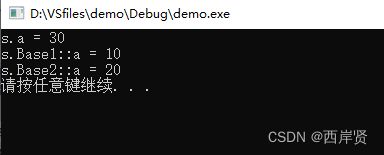
如果不加作用域,默认访问的是本类的成员变量,如果要访问不同类中的同名成员变量,需要加上作用域才能实现访问。
7.菱形继承
菱形继承:两个子类(派生类)继承了同一个父类(基类),同时又有某个类继承了两个子类,菱形继承也称钻石继承。
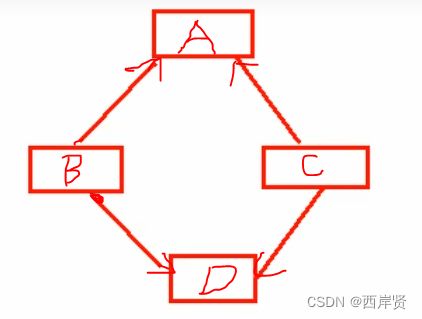
菱形继承的一个典型例子如下图所示。
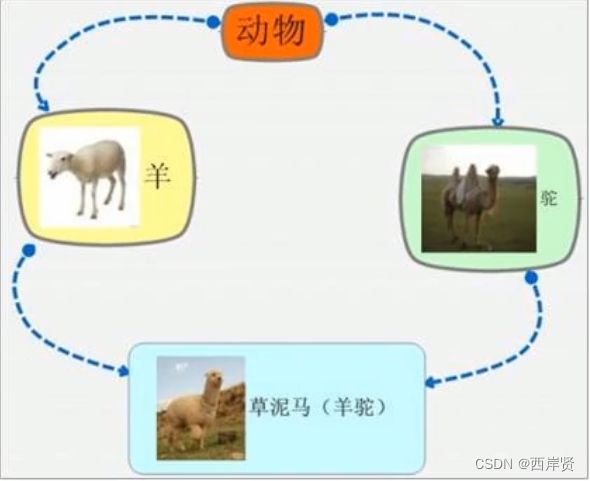
菱形继承中,子类继承父类的时候会将属性在各自的类中继承一份,因此,再有类继承子类就会得到两个相同的属性,所以菱形继承中一定存在着同名成员,导致资源浪费且有出现歧义。要利用虚继承解决同名成员的问题,在继承方式前面加上关键字virtual就代表虚继承。
虚继承继承的不再是成员的属性,而是一个虚基类指针,这两个指针在子类中通过不同的偏移量最终指向父类中的成员属性,如下图所示。
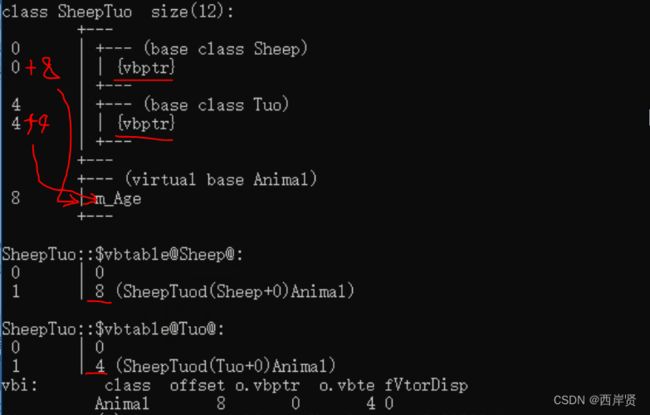
菱形继承的代码示例如下。
#include 上面代码的执行结果如下图所示。
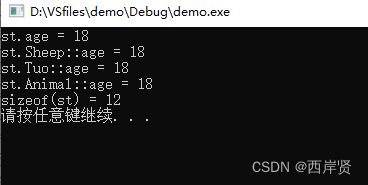
可以看到,通过虚继承,访问成员属性的时候直接通过.访问即可, 不用再加类名作为作用域,因为继承下来的数据只有一份,不会产生歧义。
最终类的大小是12个字节,其中有4个字节是继承自父类的成员属性,另外8个字节分别是来自两个派生类的虚基类指针。
若不采用虚继承的方式,上面类的大小是8个字节,父类中的成员属性被两个派生类继承了,再由一个类继承了两个派生类的属性,因此就是8字节大小。

本文参考视频:
黑马程序员匠心之作|C++教程从0到1入门编程,学习编程不再难

